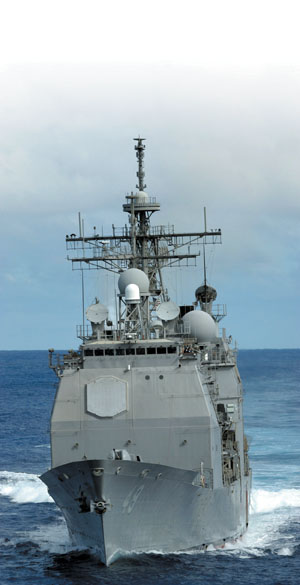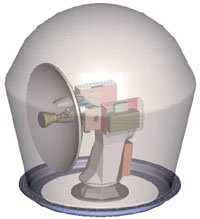Telecommunications Standard Key to Transformation
 |
| The software communications architecture (SCA) being developed by the Raytheon Company will allow U.S. Navy ships and ground facilities to communicate with high-bandwidth next-generation satellites. The SCA also creates guidelines for the development of new waveforms for software programmable radios. |
An advanced software architecture will allow the U.S. Navy to increase substantially the bandwidth and data throughput of its satellite communications systems and will serve as a bridge to the next-generation capabilities envisioned in FORCEnet and Sea Power 21. It will enter service as part of a sophisticated multiband satellite communications terminal designed to link with future spacecraft.
As the U.S. Defense Department moves toward a fully integrated Global Information Grid, it is preparing the foundations of a high-bandwidth network that will reach from foxhole to orbit. A key aspect of the transformational systems planned to anchor the grid is software programmability. By making programs and waveforms that are able to operate on a variety of equipment, the military gains savings in time, logistics and maintenance costs.
This software-based approach underlies the Navy Multiband Terminal (NMT) program. According to Michelle Bailey, manager, Communication Program Office, Program Executive Office Command, Control, Communications, Computers, Intelligence and Space, U.S. Navy, San Diego, the terminals will allow Navy ships and ground facilities to communicate with future communications satellites, such as the Wideband Gap Filler and the Advanced Extremely High Frequency (EHF) satellite.
Bailey notes that the service’s current terminals communicate on the EHF and X bands, but the two new satellites will operate on the Ka and X bands, providing greater data throughput capability. The NMT must communicate with legacy satellites and the new spacecraft that will replace them. “We want to get away from stovepipe terminals where one terminal communicates with only one type of satellite,” she says.
The overarching structure allowing the NMT to interoperate with these spacecraft and with future systems is the Defense Department’s software communications architecture (SCA). The Navy has tasked the Raytheon Company, Waltham, Massachusetts, with designing an architecture that will support communications above 2 gigahertz that can implement SCA-compliant waveforms and other functions as part of the terminal’s development. Raytheon led an industry consortium that developed previous versions of the SCA, and the company is currently working on version 2.2.1 of the standard, Bailey explains.
The standard will allow the Navy to upgrade and modify its systems to new applications quickly, Bailey says. “If all the terminals are built to the same SCA, we should be able to develop a waveform once and load it into all of our terminals,” she maintains.
The Navy plans to field a system that can be extended across a variety of applications, including its transformational communications programs, explains Steven Rosenblum, Raytheon’s director of Navy satellite communications systems, Marlborough, Massachusetts. “The Navy’s goal is to reduce life-cycle costs by not forcing a reprocurement or at least a reinstallation when the transformational MILSATCOM [military satellite communications] services are fielded. They are looking for an open architecture system that not only meets today’s missions but also bridges to tomorrow’s systems like the Wideband Gapfiller and then beyond the horizon to transformational MILSATCOM,” he says.
By providing the Navy with a flexible framework to add new systems, the service will be able to integrate future systems such as the Transformational Communications Satellite (TCS) quickly. Intended to replace the advanced EHF systems poised to enter service in the next decade, the TCS will expand this enhanced capability by an order of magnitude, says Dr. Richard Kurth, Raytheon’s technical director for NMT and Advanced Programs.
Many of the components for the SCA already exist, Rosenblum maintains. “Raytheon’s approach is to take those Defense Department investments, particularly the software that’s been developed, and step back and create the most logical MILSATCOM architecture for these systems operating above 2 gigahertz. We are reusing as much as we can from what the government owns, and that’s quite a significant amount of software,” he says.
The SCA is endorsed by the Modular Software Radio Consortium, an international standards body, as a definitive global rules set for developing commercial and military software radios. The standard’s purpose is to ensure that architectures created for specific systems will have software that is highly portable. This is achieved by isolating the program from the hardware, which allows upgrades and extensions to be added without making major changes to the system itself.
Advances in processor technology also permit software to operate on new hardware with faster microprocessors, Kurth explains. “The SCA specification or standard provides the framework, the design rules for the software and how it interfaces with the processor operating system and other functions of the microprocessor that are going to execute the software,” he says.
But challenges remain in designing the multiple bandwidth waveforms for the Navy. These include low- , medium- and extended-data rate (LDR, MDR and XDR) waveforms that will operate on the NMT and future systems. Kurth maintains that this is an increase in complexity over legacy MILSATCOM systems whose satellites mainly served as transponders. The upcoming and next-generation transformational spacecraft will have more complex software for onboard processing, allowing them to respond to specific downlink and uplink requirements.
The NMT is the first system to use the new SCA. It will consolidate existing satellite communications systems into one unit and bridge the Navy’s legacy systems to a fully joint, interoperable force, explains Glen Bassett, Raytheon’s NMT program manager. If all of the terminal program’s options are exercised, the NMT will be able to communicate with a variety of future orbital platforms such as the Wideband Gapfiller, the Advanced EHF Satellite and the TCS.
The engineering, manufacture and development contract for the NMT was awarded in October 2003 to two teams led by Raytheon and the Harris Corporation, Melbourne, Florida. After a 37-month prototype phase, the Navy will select a winner for pre-production development and operational tests. The final down-select evaluations will take place in 2006 and will consist of on-the-air tests with MILSTAR and Ultra High Frequency (UHF) Follow-On satellites. The winner will produce up to 300 terminals, the overall value of which could exceed $1.4 billion by 2014.
Raytheon was awarded a second contract in August to develop the SCA for the NMT. Bassett notes that Raytheon already has a detailed software design for the terminal system and its waveforms that fits within the existing architecture. “What we’re doing now on NMT is simply partitioning that software into the architecture that’s been chosen to be compliant with the SCA,” he says.
The NMT will use the LDR, MDR and XDR waveforms. Kurth explains that the Navy currently uses LDR and MDR waveforms, but the NMT will be able to use XDR frequencies being developed for the Advanced EHF satellite.
The new terminals will require less antenna space on ships because they will use one type of aerial. Ships often use two antennas, mounted on opposite sides of a vessel, to remain in contact with a satellite while they maneuver. The NMT can interface with the phased array antennas now being installed on new ships, but older ships mainly will use parabolic dishes. “You need a pair of dishes to point to a single satellite,” Bailey explains. “I can’t turn a parabolic antenna to look at the Wideband Gapfiller satellite and the EHF satellite because they’re not in the same spot in the sky.”
 |
| The Navy Multiband Terminal (NMT) will allow U.S. military vessels to use a single antenna to communicate with different satellites, saving space and logistics costs. The terminal is designed to remain locked on a satellite in heavy seas with 35-degree rolls. It will serve as a bridge between legacy systems, upcoming satellite constellations and future spacecraft such as the Transformational Communications Satellite. |
An added advantage of the NMT is that a single system will ease training and logistics requirements. “If I have only one kind of antenna, I may have six of them on a ship, but I only have to carry one kind of antenna power supply,” Bailey explains.
The new terminals will have greater frequency throughput than existing systems, and they are specified to be highly reliable. The current minimum requirement for the NMT is 2,200 hours of operation, but the goal is 4,400 hours—the approximate length of a six-month deployment. “When you’ve got some 18-year-old out there whose life depends on it, it has to be reliable,” says Michael O’Reilly, Harris Corporation’s program director for Naval communications.
O’Reilly notes that Harris is developing four terminal prototypes for use below deck on ships or in groundstations and additional topside equipment such as antennas. Two of these NMT prototypes will be used on ships and submarines, while the remaining two will operate on shore. Harris also will provide the shore-based antennas while the government supplies the ship-based aerials.
Harris is developing parabolic dish antennas for use by shipboard NMTs. O’Reilly describes these systems as single-beam, multiband devices capable of 30- and 40-gigabyte uplinks and 20-gigabyte downlinks. A fully operational NMT terminal would consist of one rack of equipment below deck and a variety of antennas above deck.
The core of the Harris NMT system is an SCA-compliant modem that can operate with a variety of satellite systems. He notes that the SCA will allow the terminal to communicate with next-generation satellites and automatically request specific services and bandwidth requirements.
The new terminals will have a greater data capacity than legacy systems. O’Reilly explains that the NMT is designed to operate in the tens of megabits. This is a considerable improvement over protected satellite communications systems that historically operated in the tens or hundreds of kilobits range.
Web Resources
SPAWAR, PEO C4I and Space, PEO Space Systems: http://enterprise.spawar.navy.mil
Raytheon Company: www.raytheon.com
The Harris Corporation: www.harris.com



Comments